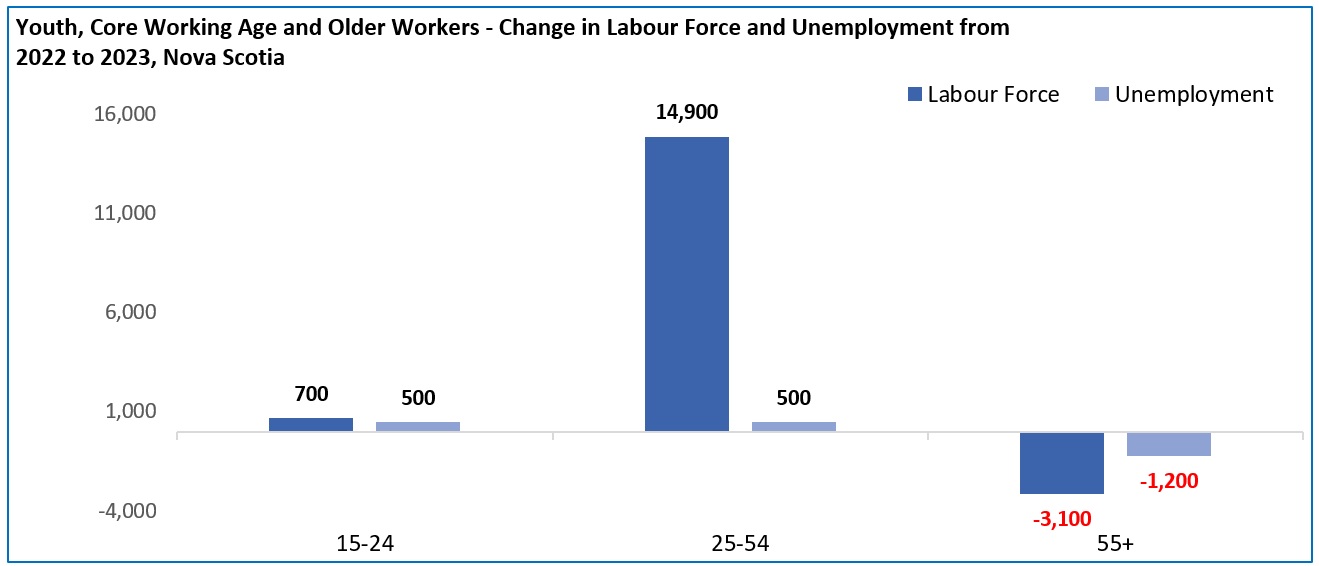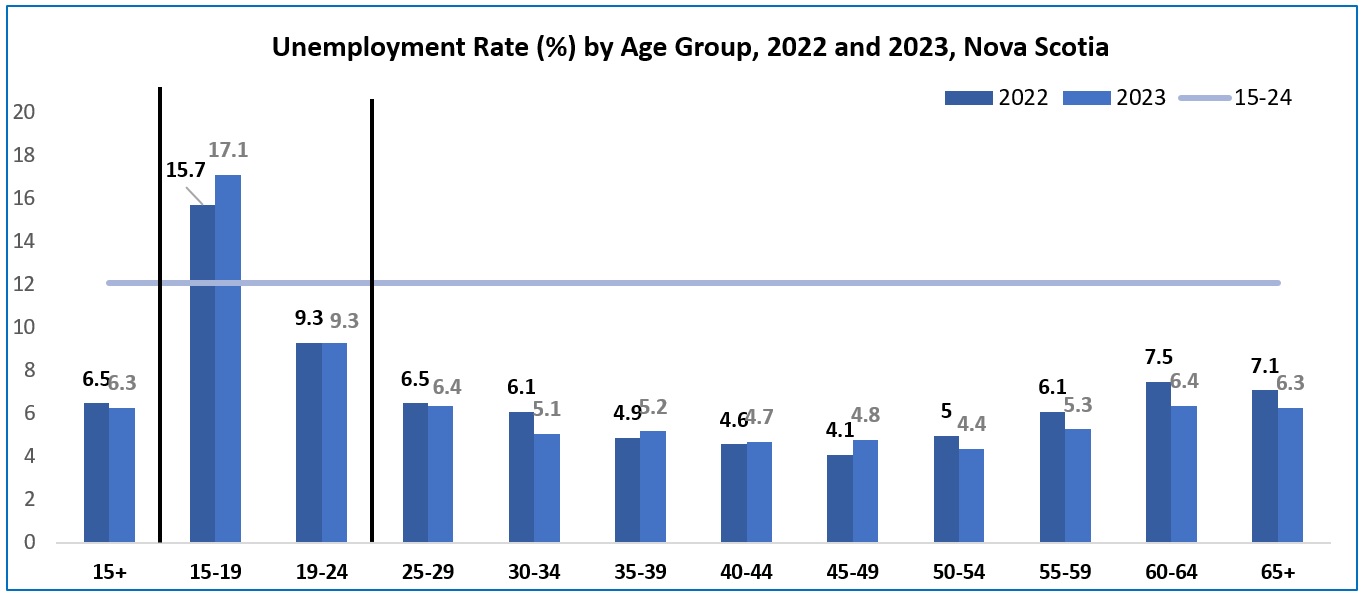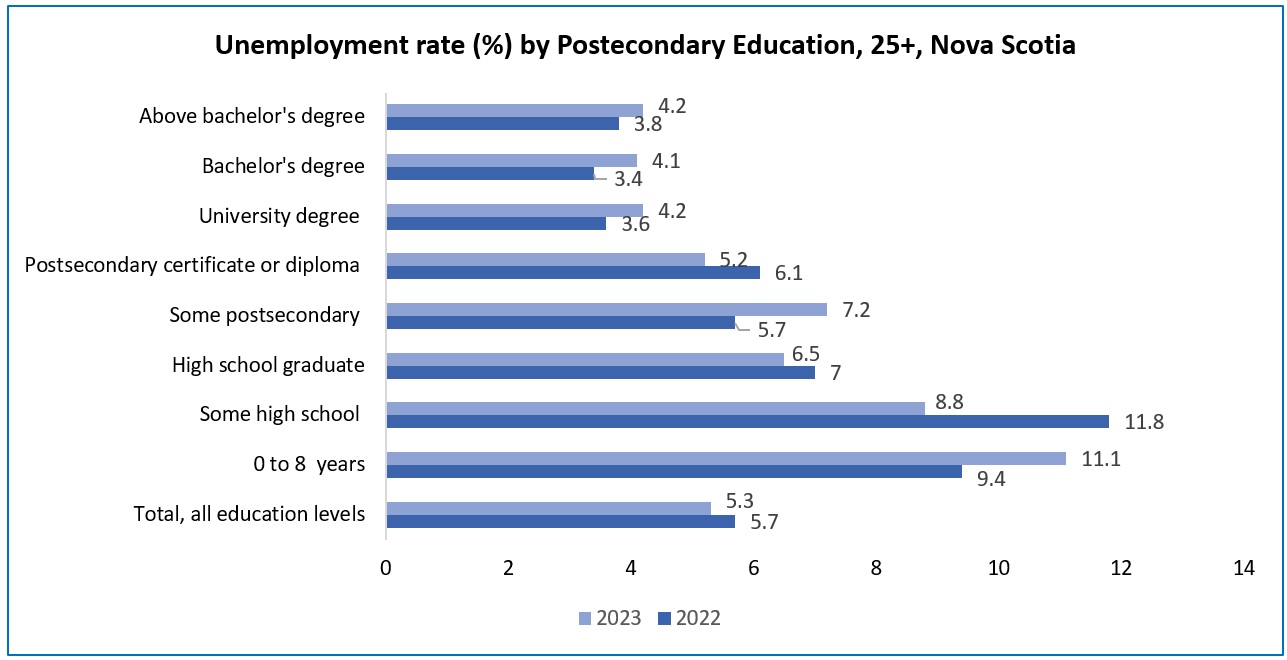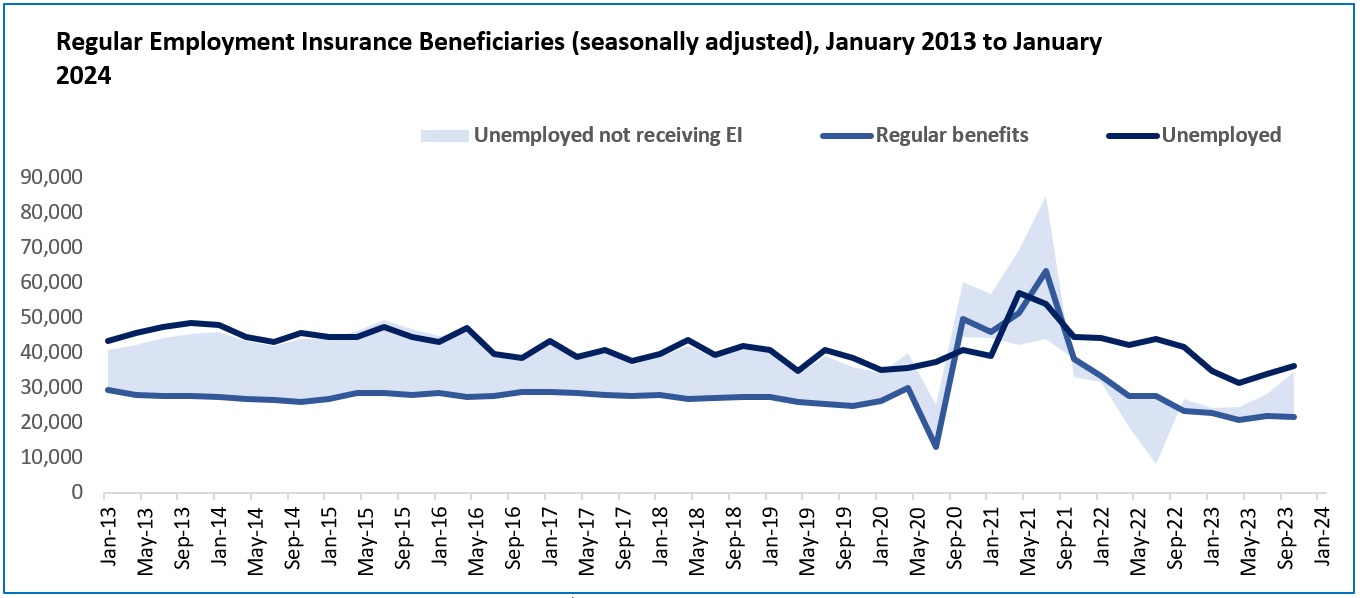Unemployment Rate by Province
The unemployment rate in Nova Scotia is still the lowest in Atlantic Canada.
- Nova Scotia’s unemployment rate rose from 7.4% in 2019 to 9.9% in 2020 due to the economic impacts of the COVID-19 pandemic. In 2021, it declined to 8.6% as the province’s economy recovered. It continued to decline in 2022 and reached 6.5%. In 2023 it declined again to 6.3%.
- In 2019, Nova Scotia’s unemployment rate was 7.4%. In 2020, many businesses had to close or cut back on staffing causing unemployment to go up to 9.9%.
- As the economy recovered through 2021, the unemployment rate went down to 8.6%. It continued to decline in 2020, reaching 6.5%, and declined again in 2023 to 6.3%.
- Nova Scotia’s unemployment rate has been the lowest compared to other Atlantic provinces since 2019. But in 2023, it was higher than the rest of the provinces and the national average.
- In 2023, more males (7.0%) were unemployed compared to females (5.6%).
- For males, the unemployment rate was the lowest it’s been in the last 10 years (since 2013), dropping from 7.3% in 2022 to 7% in 2023.
- For females, the unemployment rate was also the lowest it’s been since 2013, slightly dropping from 5.7% in 2022 to 5.6% in 2023.

Calculations based on Statistics Canada Table 14-10-0327-01 Labour force characteristics by sex and detailed age group, annual.
Age Groups
The youth unemployment rate rose in 2023 while it went down for both core age and older workers.
For youth workers aged 15 to 24 in Nova Scotia:
- The labour force grew by 700 jobs, which is a 0.9% increase, for a total of 76,200 youth workers.
- The unemployment rate went up to 12.1% in 2023, compared to 11.5% in 2022. But this was still the second lowest it has been in the last 10 years.
- More male youth were unemployed (14.5%) compared to female youth (9.6%) in 2023. However, the unemployment rate for male youth went up from 13.1% in 2022, while it went down for female youth from 10% in 2022.
- Except for 2022 for male youth, the unemployment rates for both male and female youth are the lowest since 2013.
- Nova Scotia had the second lowest youth unemployment rate in Atlantic Canada after New Brunswick.
For core age (aged 25 to 54) workers in Nova Scotia:
- There were 14,900 more jobs available, which is a 4.7% increase, for a total of 331,600 workers.
- The unemployment rate for this age group went down to 5.1% in 2023, just a bit lower than 5.2% in 2022.
- The male unemployment rate was 5.5%, down from 6.2% in 2022. For females, it was 4.8%, up from 4.2% in 2022.
- Nova Scotia has the lowest unemployment rate for this age group in Atlantic Canada, being on par with New Brunswick.
For older workers aged 55 years and older:
- The labour force went down by 3,100 people, which is a decrease of 2.4% since 2022, for a total of 123,500 workers.
- The unemployment rate went down to 5.9% in 2023, from 6.7% in 2022.
- Older workers in Nova Scotia had the lowest unemployment rate in Atlantic Canada
- Even among workers aged 65 and over, there were more jobs, with 700 more people working, which is a 2.4% increase. The number of unemployed in this age group went down by 200, or 9.5%, and their unemployment rate also decreased to 6.3%, which is 0.8 percentage points lower.

Calculations based on Statistics Canada Table 14-10-0327-01 Labour force characteristics by sex and detailed age group, annual.

Calculations based on Statistics Canada Table 14-10-0327-01 Labour force characteristics by sex and detailed age group, annual.
Location of Study
People who earned their college or university education in Nova Scotia had a higher unemployment rate than those who went to college or university elsewhere, according to the 2021 Census of Population.
In Nova Scotia:
- People who went to college or university, including those with certificates or diplomas, had a lower unemployment rate in 2023 than the overall provincial unemployment rate, which was 5.4%.
- The unemployment rates varied depending on the type of college or university education and where people got their education, according to the 2021 Census data.
- Overall, those who earned their college or university education in Nova Scotia had a higher unemployment rate than those who studied elsewhere. This is mainly influenced by those with apprenticeships or trades certificates or diplomas.
- People with college or university credentials below a bachelor’s degree level that they earned in another province had higher unemployment rates than those who earned them in Nova Scotia. But those with credentials higher than a bachelor’s degree level that was earned in Nova Scotia had higher unemployment rates than those earned elsewhere.
- The biggest difference in unemployment rates between credentials earned in and outside of Nova Scotia was for people with degrees in medicine, dentistry, veterinary medicine, or optometry. It should be noted that anyone who wants to study veterinary medicine or optometry needs to earn those credentials outside of Nova Scotia. People with credentials in medicine, dentistry, veterinary medicine, or optometry have the lowest rates of unemployment in Nova Scotia regardless or where they studied.
- For both non-certified and certified trades, those that were earned in the province made it generally easier to find a job in Nova Scotia. This differs from 2016 when the unemployment rate for non-certified trades earned in Nova Scotia was higher than for those who earned it outside of the province. This differs than the situation in 2016 when unemployment rate for those with noncertified trade obtained in Nova Scotia was higher than for those who obtained it outside of the province.

Calculations based on Statistics Canada Table 98-10-0445-01 Labour force status by major field of study, highest level of education, location of study compared with location of residence, age and gender.
In 2023, people who had some high school education, those who completed high school or an equivalent, and those who earned a college or university certificate or diploma had lower unemployment rates than in 2022.

Calculations based on Statistics Canada Table 14-10-0020-01 Unemployment rate, participation rate and employment rate by educational attainment, annual
Employment Insurance
Recipients of Employment Insurance (EI) in Nova Scotia is trending downward.
- Between January 2012 and February 2020, the seasonally adjusted number of people in Nova Scotia receiving regular Employment Insurance (EI) benefits went down. But from October 2020 to September 2021, it spiked. Then, from January 2022 onwards (including January 2023), it started going down again.
- When the COVID-19 pandemic hit Nova Scotia, a lot of people lost their jobs, and many of them started receiving EI benefits. But from March 15th to October 3rd, 2020, people who were out of work could also claim the Canadian Emergency Response Benefit (CERB), which was temporary financial assistance.
- In the spring and summer of 2020, more people were out of work, but fewer were getting EI benefits because many were being redirected to the CERB program.
- When the CERB program ended in the fall of 2020, the rules for getting EI were changed temporarily. This allowed more people like students, youth, and occasional workers to get EI. As a result, from October 2020 to September 2021, more people were getting EI benefits than were unemployed.
- But by October to December 2021, as the temporary changes to EI ended, more people were unemployed again than were getting EI benefits. By January 2022, the number of seasonally adjusted EI recipients went down to about historical norms. This trend continued to the present time, including January 2023 and October 2023.

Calculations based on Statistics Canada Tables 14-10-0011-01 (formerly CANSIM 276-0022) and 14-10-0287-01 (formerly CANSIM 282- 0087)